示波器文献综述
- 格式:docx
- 大小:159.01 KB
- 文档页数:8
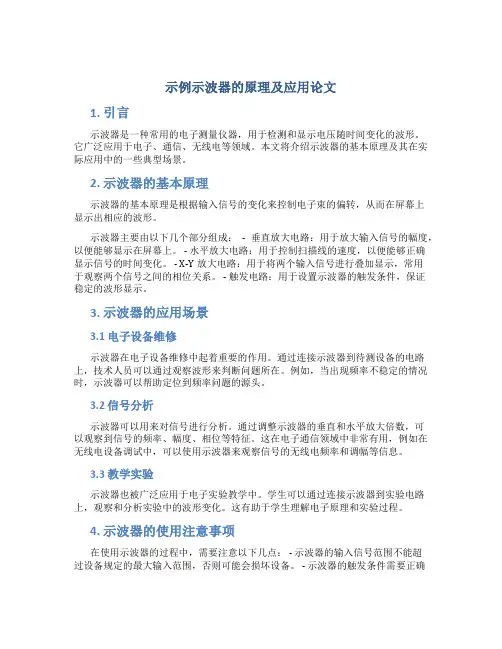
示例示波器的原理及应用论文1. 引言示波器是一种常用的电子测量仪器,用于检测和显示电压随时间变化的波形。
它广泛应用于电子、通信、无线电等领域。
本文将介绍示波器的基本原理及其在实际应用中的一些典型场景。
2. 示波器的基本原理示波器的基本原理是根据输入信号的变化来控制电子束的偏转,从而在屏幕上显示出相应的波形。
示波器主要由以下几个部分组成:- 垂直放大电路:用于放大输入信号的幅度,以便能够显示在屏幕上。
- 水平放大电路:用于控制扫描线的速度,以便能够正确显示信号的时间变化。
- X-Y放大电路:用于将两个输入信号进行叠加显示,常用于观察两个信号之间的相位关系。
- 触发电路:用于设置示波器的触发条件,保证稳定的波形显示。
3. 示波器的应用场景3.1 电子设备维修示波器在电子设备维修中起着重要的作用。
通过连接示波器到待测设备的电路上,技术人员可以通过观察波形来判断问题所在。
例如,当出现频率不稳定的情况时,示波器可以帮助定位到频率问题的源头。
3.2 信号分析示波器可以用来对信号进行分析。
通过调整示波器的垂直和水平放大倍数,可以观察到信号的频率、幅度、相位等特征。
这在电子通信领域中非常有用,例如在无线电设备调试中,可以使用示波器来观察信号的无线电频率和调幅等信息。
3.3 教学实验示波器也被广泛应用于电子实验教学中。
学生可以通过连接示波器到实验电路上,观察和分析实验中的波形变化。
这有助于学生理解电子原理和实验过程。
4. 示波器的使用注意事项在使用示波器的过程中,需要注意以下几点: - 示波器的输入信号范围不能超过设备规定的最大输入范围,否则可能会损坏设备。
- 示波器的触发条件需要正确设置,以保证稳定的波形显示。
- 连接示波器到待测电路时,需要注意正确的接地方式,避免出现误差。
5. 结论示波器是一种重要的测量仪器,具有广泛的应用前景。
本文介绍了示波器的基本原理和一些常见的应用场景,以及在使用示波器时需要注意的事项。
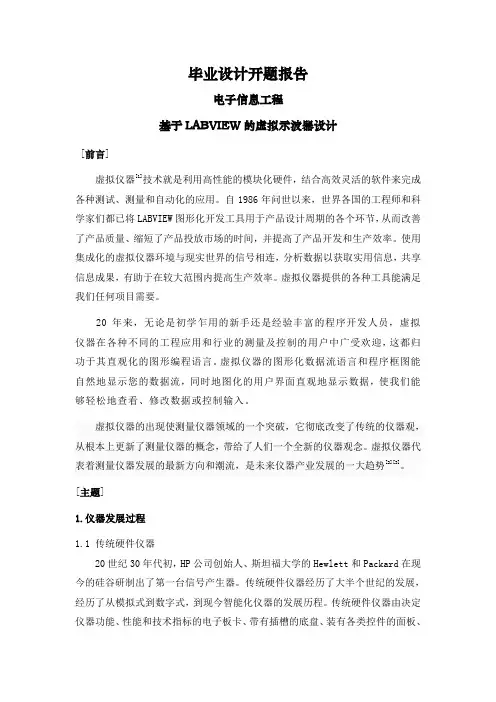
毕业设计开题报告电子信息工程基于LABVIEW的虚拟示波器设计[前言]虚拟仪器[1]技术就是利用高性能的模块化硬件,结合高效灵活的软件来完成各种测试、测量和自动化的应用。
自1986年问世以来,世界各国的工程师和科学家们都已将LABVIEW图形化开发工具用于产品设计周期的各个环节,从而改善了产品质量、缩短了产品投放市场的时间,并提高了产品开发和生产效率。
使用集成化的虚拟仪器环境与现实世界的信号相连,分析数据以获取实用信息,共享信息成果,有助于在较大范围内提高生产效率。
虚拟仪器提供的各种工具能满足我们任何项目需要。
20年来,无论是初学乍用的新手还是经验丰富的程序开发人员,虚拟仪器在各种不同的工程应用和行业的测量及控制的用户中广受欢迎,这都归功于其直观化的图形编程语言。
虚拟仪器的图形化数据流语言和程序框图能自然地显示您的数据流,同时地图化的用户界面直观地显示数据,使我们能够轻松地查看、修改数据或控制输入。
虚拟仪器的出现使测量仪器领域的一个突破,它彻底改变了传统的仪器观,从根本上更新了测量仪器的概念,带给了人们一个全新的仪器观念。
虚拟仪器代表着测量仪器发展的最新方向和潮流,是未来仪器产业发展的一大趋势[2][3]。
[主题]1.仪器发展过程1.1 传统硬件仪器20世纪30年代初,HP公司创始人、斯坦福大学的Hewlett和Packard在现今的硅谷研制出了第一台信号产生器。
传统硬件仪器经历了大半个世纪的发展,经历了从模拟式到数字式,到现今智能化仪器的发展历程。
传统硬件仪器由决定仪器功能、性能和技术指标的电子板卡、带有插槽的底盘、装有各类控件的面板、显示器和机箱等五部分构成。
传统硬件仪器是硬件或以硬件为主的仪器,即使是智能仪器,其中固化的软件也只是辅助性的。
传统硬件仪器是一个封闭系统,一经厂家制造完毕,不能随意改动,灵活性较低。
无论是对技术的进步还是对市场的需求,其响应速度都比较慢,这在很大程度上阻碍了仪器科学和仪器。
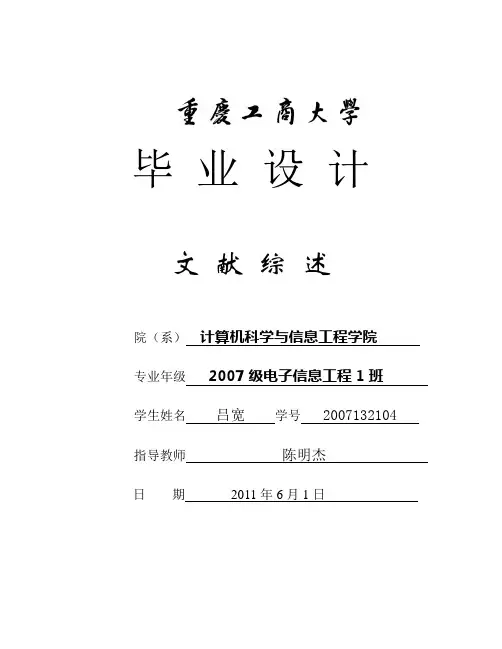
毕业设计文献综述院(系)计算机科学与信息工程学院专业年级 2007级电子信息工程1班学生姓名吕宽学号 2007132104 指导教师陈明杰日期2011年6月1日数字存储示波器的设计吕宽(重庆工商大学计算机科学与信息工程学院电子信息工程2007级1班)摘要随着科学技术的发展,作为常用的检测工具,示波器的面貌也焕然一新。
由于数字技术的采用,示波器成为集显示、测量、运算、分析、记录等各种功能于一体的智能化测量仪器。
数字存储示波器(DSO)将取代模拟示波器。
目前,国内具有自主知识产权的数字存储示波器产品还非常少,高昂的价格阻碍了数字存储示波器在生产和试验中广泛的应用。
在研究剖析数字存储示波器产品工作原理的基础上,本文利用NIOS II设计示波器,并详细论述了其设计和实现过程。
关键词数字存储示波器 NIOS IIABSTRACT With the development of science and technology, the oscilloscopes, as common instruments, have made great progress. With digital technology, the oscilloscopes have become a kind of intelligent instrument with functions: waveform display, parameter measure,detecting,analyze, storage, and so on. The Digital Storage Oscilloscope (DSO) will replace Analog Oscilloscope. At present, domestic DSO product's type, which has our own independent property right, is too few. The DSO is hindered to apply wildly in our production and test by high price. On the basis of the analysis of DSO's fundamental principle, the design and implementation of a kind of portable digital storage oscilloscope system was discussed in detailed in the dissertation.KEY WORDS DSO NIOS II目录1、绪论 (5)1 .1、示波器简介 (5)1.2课题背景及主要工作 (6)2、硬件设计 (8)3、软件设计 (9)4、现阶段国内外发展情况 (10)5. 数字存储示波器的将来 (11)6. 结语 (12)参考文献: (13)1、绪论1 .1、示波器简介人类在认识自然和改造自然的过程中,必定要进行测量活动。
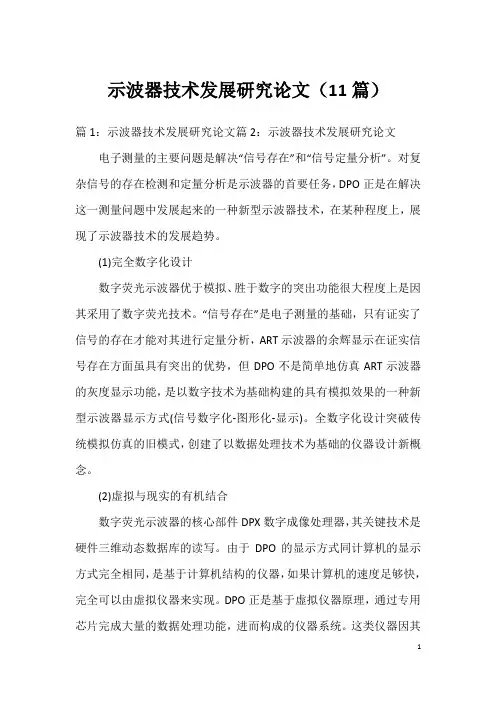
示波器技术发展研究论文(11篇)篇1:示波器技术发展研究论文篇2:示波器技术发展研究论文电子测量的主要问题是解决“信号存在”和“信号定量分析”。
对复杂信号的存在检测和定量分析是示波器的首要任务,DPO正是在解决这一测量问题中发展起来的一种新型示波器技术,在某种程度上,展现了示波器技术的发展趋势。
(1)完全数字化设计数字荧光示波器优于模拟、胜于数字的突出功能很大程度上是因其采用了数字荧光技术。
“信号存在”是电子测量的基础,只有证实了信号的存在才能对其进行定量分析,ART示波器的余辉显示在证实信号存在方面虽具有突出的优势,但DPO不是简单地仿真ART示波器的灰度显示功能,是以数字技术为基础构建的具有模拟效果的一种新型示波器显示方式(信号数字化-图形化-显示)。
全数字化设计突破传统模拟仿真的旧模式,创建了以数据处理技术为基础的仪器设计新概念。
(2)虚拟与现实的有机结合数字荧光示波器的核心部件DPX数字成像处理器,其关键技术是硬件三维动态数据库的读写。
由于DPO的显示方式同计算机的显示方式完全相同,是基于计算机结构的仪器,如果计算机的速度足够快,完全可以由虚拟仪器来实现。
DPO正是基于虚拟仪器原理,通过专用芯片完成大量的数据处理功能,进而构成的仪器系统。
这类仪器因其运算速度快具有实时性的特点,它的便携性克服了虚拟仪器不利现场使用的缺点,体现了现代仪器的发展方向。
篇3:建筑工程技术发展研究论文建筑工程技术发展研究论文1建筑工程的现状1.1建筑工程的发展现状虽然我国在严格控制着人口的增长,但是我国人口的增多已经是一个不可回避的问题,土地的使用满足不了人们的需求,因此,建筑出现了。
建筑能够减缓这一问题。
它占用了相对较小的土地面积从而容纳了大量的人口,解决了人们的居住问题。
对于高层的建筑,建造时的危险系数很高。
一般的低层建筑的地基方面的要求不会过高,而建筑的所有结构都是在地基之上建造而成,因为许多建筑的高度大,因此,需要的材料多,受到外界因素的可能性就相对很大。
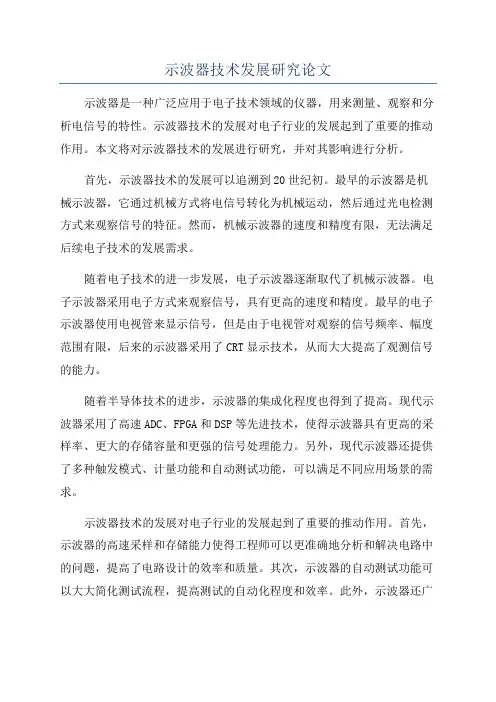
示波器技术发展研究论文示波器是一种广泛应用于电子技术领域的仪器,用来测量、观察和分析电信号的特性。
示波器技术的发展对电子行业的发展起到了重要的推动作用。
本文将对示波器技术的发展进行研究,并对其影响进行分析。
首先,示波器技术的发展可以追溯到20世纪初。
最早的示波器是机械示波器,它通过机械方式将电信号转化为机械运动,然后通过光电检测方式来观察信号的特征。
然而,机械示波器的速度和精度有限,无法满足后续电子技术的发展需求。
随着电子技术的进一步发展,电子示波器逐渐取代了机械示波器。
电子示波器采用电子方式来观察信号,具有更高的速度和精度。
最早的电子示波器使用电视管来显示信号,但是由于电视管对观察的信号频率、幅度范围有限,后来的示波器采用了CRT显示技术,从而大大提高了观测信号的能力。
随着半导体技术的进步,示波器的集成化程度也得到了提高。
现代示波器采用了高速ADC、FPGA和DSP等先进技术,使得示波器具有更高的采样率、更大的存储容量和更强的信号处理能力。
另外,现代示波器还提供了多种触发模式、计量功能和自动测试功能,可以满足不同应用场景的需求。
示波器技术的发展对电子行业的发展起到了重要的推动作用。
首先,示波器的高速采样和存储能力使得工程师可以更准确地分析和解决电路中的问题,提高了电路设计的效率和质量。
其次,示波器的自动测试功能可以大大简化测试流程,提高测试的自动化程度和效率。
此外,示波器还广泛应用于电子制造、通信、医疗、教育等领域,为这些行业的发展提供了重要的支持。
然而,当前示波器技术仍存在一些挑战和问题。
首先,示波器的采样率和存储容量已经达到了极限,难以满足未来更高频率和更复杂信号的观测需求。
其次,示波器的尺寸和功耗仍较大,不方便携带和使用。
最后,示波器的操作和分析功能仍有一定的限制,需要进一步完善和提高。
综上所述,示波器技术的发展对电子行业的发展起到了重要的推动作用。
随着电子技术的不断进步,示波器技术也在不断发展和完善。
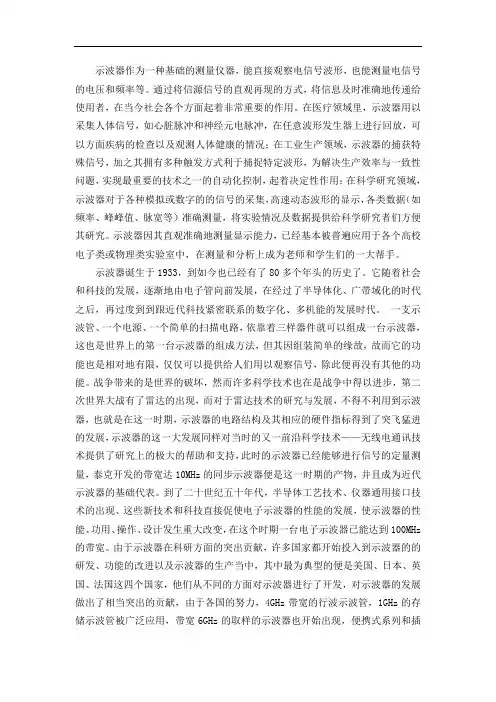
示波器作为一种基础的测量仪器,能直接观察电信号波形,也能测量电信号的电压和频率等。
通过将信源信号的直观再现的方式,将信息及时准确地传递给使用者,在当今社会各个方面起着非常重要的作用。
在医疗领域里,示波器用以采集人体信号,如心脏脉冲和神经元电脉冲,在任意波形发生器上进行回放,可以方面疾病的检查以及观测人体健康的情况;在工业生产领域,示波器的捕获特殊信号,加之其拥有多种触发方式利于捕捉特定波形,为解决生产效率与一致性问题,实现最重要的技术之一的自动化控制,起着决定性作用;在科学研究领域,示波器对于各种模拟或数字的的信号的采集,高速动态波形的显示,各类数据(如频率、峰峰值、脉宽等)准确测量,将实验情况及数据提供给科学研究者们方便其研究。
示波器因其直观准确地测量显示能力,已经基本被普遍应用于各个高校电子类或物理类实验室中,在测量和分析上成为老师和学生们的一大帮手。
示波器诞生于1933,到如今也已经有了80多个年头的历史了。
它随着社会和科技的发展,逐渐地由电子管向前发展,在经过了半导体化、广带域化的时代之后,再过度到到跟近代科技紧密联系的数字化、多机能的发展时代。
一支示波管、一个电源、一个简单的扫描电路,依靠着三样器件就可以组成一台示波器,这也是世界上的第一台示波器的组成方法,但其因组装简单的缘故,故而它的功能也是相对地有限,仅仅可以提供给人们用以观察信号,除此便再没有其他的功能。
战争带来的是世界的破坏,然而许多科学技术也在是战争中得以进步,第二次世界大战有了雷达的出现,而对于雷达技术的研究与发展,不得不利用到示波器,也就是在这一时期,示波器的电路结构及其相应的硬件指标得到了突飞猛进的发展,示波器的这一大发展同样对当时的又一前沿科学技术——无线电通讯技术提供了研究上的极大的帮助和支持,此时的示波器已经能够进行信号的定量测量,泰克开发的带宽达10MHz的同步示波器便是这一时期的产物,并且成为近代示波器的基础代表。
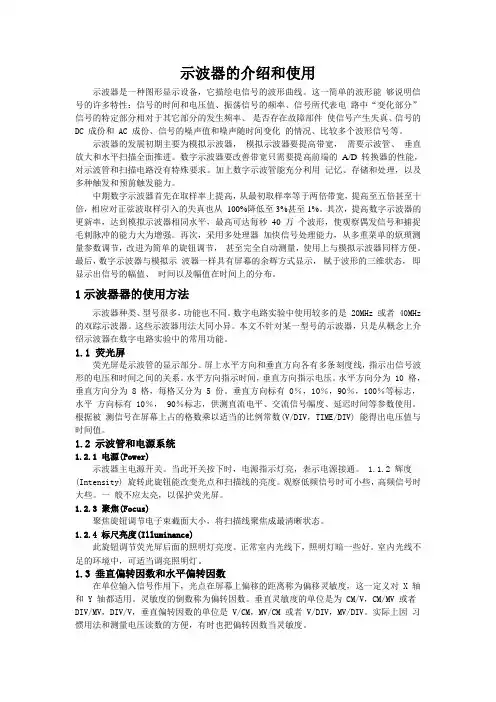
示波器的介绍和使用示波器是一种图形显示设备,它描绘电信号的波形曲线。
这一简单的波形能够说明信号的许多特性:信号的时间和电压值、振荡信号的频率、信号所代表电路中“变化部分”信号的特定部分相对于其它部分的发生频率、是否存在故障部件使信号产生失真、信号的DC 成份和 AC 成份、信号的噪声值和噪声随时间变化的情况、比较多个波形信号等。
示波器的发展初期主要为模拟示波器,模拟示波器要提高带宽,需要示波管、垂直放大和水平扫描全面推进。
数字示波器要改善带宽只需要提高前端的A/D 转换器的性能,对示波管和扫描电路没有特殊要求。
加上数字示波管能充分利用记忆、存储和处理,以及多种触发和预前触发能力。
中期数字示波器首先在取样率上提高,从最初取样率等于两倍带宽,提高至五倍甚至十倍,相应对正弦波取样引入的失真也从100%降低至3%甚至1%。
其次,提高数字示波器的更新率,达到模拟示波器相同水平,最高可达每秒40 万个波形,使观察偶发信号和捕捉毛刺脉冲的能力大为增强。
再次,采用多处理器加快信号处理能力,从多重菜单的烦琐测量参数调节,改进为简单的旋钮调节,甚至完全自动测量,使用上与模拟示波器同样方便。
最后,数字示波器与模拟示波器一样具有屏幕的余辉方式显示,赋于波形的三维状态,即显示出信号的幅值、时间以及幅值在时间上的分布。
1示波器器的使用方法示波器种类、型号很多,功能也不同。
数字电路实验中使用较多的是 20MHz 或者 40MHz 的双踪示波器。
这些示波器用法大同小异。
本文不针对某一型号的示波器,只是从概念上介绍示波器在数字电路实验中的常用功能。
1.1 荧光屏荧光屏是示波管的显示部分。
屏上水平方向和垂直方向各有多条刻度线,指示出信号波形的电压和时间之间的关系。
水平方向指示时间,垂直方向指示电压。
水平方向分为 10 格,垂直方向分为 8 格,每格又分为 5 份。
垂直方向标有 0%,10%,90%,100%等标志,水平方向标有 10%, 90%标志,供测直流电平、交流信号幅度、延迟时间等参数使用。
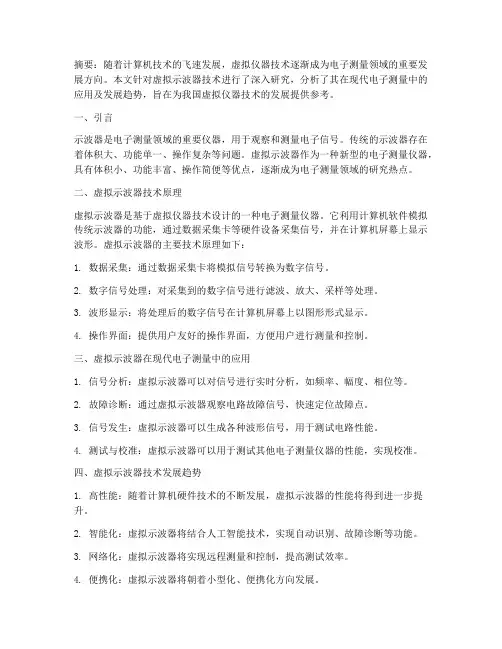
摘要:随着计算机技术的飞速发展,虚拟仪器技术逐渐成为电子测量领域的重要发展方向。
本文针对虚拟示波器技术进行了深入研究,分析了其在现代电子测量中的应用及发展趋势,旨在为我国虚拟仪器技术的发展提供参考。
一、引言示波器是电子测量领域的重要仪器,用于观察和测量电子信号。
传统的示波器存在着体积大、功能单一、操作复杂等问题。
虚拟示波器作为一种新型的电子测量仪器,具有体积小、功能丰富、操作简便等优点,逐渐成为电子测量领域的研究热点。
二、虚拟示波器技术原理虚拟示波器是基于虚拟仪器技术设计的一种电子测量仪器。
它利用计算机软件模拟传统示波器的功能,通过数据采集卡等硬件设备采集信号,并在计算机屏幕上显示波形。
虚拟示波器的主要技术原理如下:1. 数据采集:通过数据采集卡将模拟信号转换为数字信号。
2. 数字信号处理:对采集到的数字信号进行滤波、放大、采样等处理。
3. 波形显示:将处理后的数字信号在计算机屏幕上以图形形式显示。
4. 操作界面:提供用户友好的操作界面,方便用户进行测量和控制。
三、虚拟示波器在现代电子测量中的应用1. 信号分析:虚拟示波器可以对信号进行实时分析,如频率、幅度、相位等。
2. 故障诊断:通过虚拟示波器观察电路故障信号,快速定位故障点。
3. 信号发生:虚拟示波器可以生成各种波形信号,用于测试电路性能。
4. 测试与校准:虚拟示波器可以用于测试其他电子测量仪器的性能,实现校准。
四、虚拟示波器技术发展趋势1. 高性能:随着计算机硬件技术的不断发展,虚拟示波器的性能将得到进一步提升。
2. 智能化:虚拟示波器将结合人工智能技术,实现自动识别、故障诊断等功能。
3. 网络化:虚拟示波器将实现远程测量和控制,提高测试效率。
4. 便携化:虚拟示波器将朝着小型化、便携化方向发展。
五、结论虚拟示波器技术在现代电子测量领域具有广阔的应用前景。
随着计算机技术和虚拟仪器技术的不断发展,虚拟示波器将在性能、智能化、网络化等方面取得更大的突破。
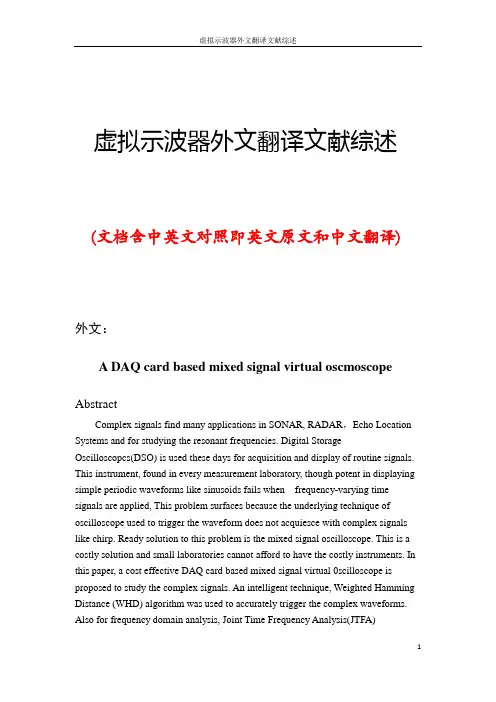
虚拟示波器外文翻译文献综述(文档含中英文对照即英文原文和中文翻译)外文:A DAQ card based mixed signal virtual oscmoscopeAbstractComplex signals find many applications in SONAR, RADAR,Echo Location Systems and for studying the resonant frequencies. Digital StorageOscilloscopcs(DSO) is used these days for acquisition and display of routine signals. This instrument, found in every measurement laboratory, though potent in displaying simple periodic waveforms like sinusoids fails when frequency-varying time signals are applied, This problem surfaces because the underlying technique of oscilloscope used to trigger the waveform does not acquiesce with complex signals like chirp. Ready solution to this problem is the mixed signal oscilloscope. This is a costly solution and small laboratories cannot afford to have the costly instruments. In this paper, a cost effective DAQ card based mixed signal virtual 0scilloscope is proposed to study the complex signals. An intelligent technique, Weighted Hamming Distance (WHD) algorithm was used to accurately trigger the complex waveforms. Also for frequency domain analysis, Joint Time Frequency Analysis(JTFA)techniques were used. A LabVlEW'TM based virtual instrument was designed and developed with a capability to acquire, display and analyze the triggered signal. The integrated programming language LabVIEWTM was chosen as it offers many simple ready to use functions. In a way the proposal offers a cost effective, fast and flexible solution to treat the complex signals. The need to create such solutions is the consequence of costly hardware systems. The deficiency of conventional hardware. Scheme for the virtual oscilloscope for complex signals with some real time experimental results are presented in this work.Kevywords: Virtual instrumentation,Chirp signal,Data acquisition,Triggering, Complex signals, JTFA1.IntroductionFor the last two decades there has been a tremendous progress in computer technology. Measurement domain is no longer left unaffected. The way measurements are being done is totally revolutionized. Computer based measurement or say virtual instrumentation is gradually replacing the costly bench top instrumentation as it offers flexible,fast and cost effective solutions. Various classical instrumentation systems namely Oscilloscope, Multimeters and Spectrum analyzers ect. are almost phased out by their counter part virtual instrumentation. Our research extends the trend and demonstrates the developmen of the computer based mixed signal digital oscilloscope.Conventional signals such as the sinusoids have a constant frequency and the amplitede only varies with time throughout the signal definition. On the other hand, complex signals can be defined in this context as signals in which all the parameters vary. Fig.1 shows a typical complex signal i.e. Linear Chirp.Variation of amplitude and frequency with time can easily be understood by having a look at the signal. This requires a visually stable display of signal. The complex signal offers challenges f'or acquisition, display an analysis. Even the conventional modern age DSO is not capable of displaying and analyzing complex signals because these instruments employ simple triggering technique like level trigger. The conventional technnique of voltage trigger apparently fails when complex signals like chirp are analyzed on DSO. This is due to the very fact that these instruments consider chirp as a conventional sine wave and trigger for each cycle of the sine wave instead of triggering for the complete chirp cycle. This analysis of the chirp signal as several sine waveforms of different frequencies leadsthe DSO to display them as sinusoids in quick succession. As this rapid change occues at a very high rate and because of human eye not registering events occurring faster than 1/20th of a second the display appears as several overlapped sine waves. In the recent work[1], a new triggering technique was proposed for the complex signals based on WHD. Subsequent sections present the solution to the problem. For analysis of the complex signals in frequency domain JFFA technique is utilized and implemented[2-6].DSO uses the level trigger to display the waveform applied to it. This leads to trigger interval and the number of samples for this trigger interval is computed and these numbers of samples are display. The DSO considers the interval as the fundamental time period of the whole waveform and thus takes tbat much samples from its buffer and starts displaying it in quick succession. With simple waveform like a sine wave, level trigger can achieve stable display because trigger interval contains same number of cycles. This is shown in Fig. 2a.Now for the complex signal as shown in Fig.2b, level triggering produces a trigger interval having variable number of cycles for the same number ofsamples/time resulting in a visually unstable display.The actual trigger interval should be one complete cycle for a chirp signal as indicated in Fig. 2c. Having done this the repeated chirp signal for this time durationwill be displayed without any overlapping components as long as the entire time period is displayed.To observe the shortcomings experimentally in display of complex signals on the oscilloscope Tektronix dual channel signal generator AFG-3022 (250 MS/s, 25 MHz) was used to generate a chirp signal by choosing the sweep mode to sine waveform with its frequency varying linearly with respect to time. This signal was fed to TektronixTDS-2022 (2 GS/s, 200MHz) dual-channel DSO. The overlapping display as shown in Fig. 3 was observed.2. Intelligent method of triggeringAccurate triggering lies solely on correct identification of the time period of waveform under consideration. For this purpose, pattern recognition scheme was implemented to identify the pattern in the signal [1] and thus obtain the time periodof one complete cycle of the chirp. First, a fixed number of samples N are taken as reference pattern. Then the signal is shifted by one sample to form the test pattern. This pattern is then tested for its closeness' to the reference pattern. Closeness' can be defined as the distance by which test pattern is away from reference pattern.WHD is used as the decision function for closeness. Hamming distance is defined for two binary vectors as the number of different' bits are given their vectors. In WHD the different bits are given their binary weighting according to the bit position and their weights according to the bit position and their weights are summed up. WHD of two binary n bit number x and a is given byIf X and A are two binary vectors of n-bits element, then WHD for these two vectors is computed by summing up the element by element WHD and is given byFor a vector of dimension N, the samples are shifted N times and its closeness is computed at each shift.When these computations are done, the difference洫in the signals is found to be minimum (ideally zero when no noise) when the cycle repeated itself. Following are the major steps involved and implemented for intelligent trigger mechanism.1. Acquiring the long enough signal using DAQ card and to convert the decimal values of samples into binary form.2.A fixed number(N) of binary samples are stored in array. The stored samples are shifted by a fixedc number of samples, n (=1,inthis case).3. The original saved samples and the shifted samples are XORed bit-by-bit.The result is then multiplied by a factor of 2, where I represent the position of bit.4.The summation of all the resulting values gives the WHD for nth shifts.5.A plot of WHD vs. n is made and the minimum is calculated by peak detection method. The difference between two successive minima is the trigger interval in number of samples.6. The number of samples multiplied by the sampling rate results in trigger interval (in seconds).As a test case WHD algorithm is implemented for the following triangular waveforrn in Fig.4.The waveform is sampled at 8 points per eycle. Each sampled value is 3 bit length.The step by step implementation is given below.WHD waveforrn is plotted using WHD(1), WHD(2), …, WHD(8), and the location of the minima gives the triggering interval. Fig.5 shows the WHD waveform also clearly indicating the trigger interval at 8th sample.The WHD VI(Fig.6) was developed for this task. It takes the waveform, whose triggering interval is to be found, and the no of samples, on which computation is to be done, as input and outputs the sample at which minima occurs along with the value of minima and the WHD waveform. For typical chirp signal WHD waveform is obtained as shown in Fig.7. The number of samples between two consecutiveminima is equal to the number of samples in one cycle of the waveform. The product of the number of samples with the sampling interval is the triggering interval of the input signal. Thus, the virtual instrument could also display complex waveforms with considerable aese. Fig.7 shows triggering interval of 5 cycles.3. Frequency domain analysisFor simple signals the frequency analysis is performed by traditional tools like FFT. For such signals the Fourier Transform works well as their frequency components remain constant throughout the signal existence and hence there is no need for the time-frequency relationship. In case of complex signals the frequency varies with time. FFT fails to analyze these signals as it gives information about the frequency and its amplitude. Time information is lost.In order to overcome this difficulty, there are JTFA tools iike Short Time Fourier Transform(STFT) and Wavelet Transform. These are implemented for the signals under consideration.The STFT is a modified form of Fourier Transform. In this technique the signal is rnultiplied with a window function and their product's Fourier Transform (2).The main principle behind this technique is that the window function(w) breaks down the signal into segments of small finite durtion. The frequency component of the signal during this segment is assumed to be constant. By computing the Fourier Transform for this segment the frequency vs. amplitude information is obtained. Then the window is moved to another segment by a step having the same duration as the previous one giving the frequency component for that segment. Thus the frequency for different time intervals gives time-frequency relationship.However, there is a disadvantage with this tecnique. The size of the window function used is fixed, thus STFT will have same resolution for low and high frequencies. Resolution is the certainty by which one can determine time or frequency information. It is generally seen that a larger window leads to better frequency resolution and a small window leads to better time resolution. Thus, it depends upon the user whether he wants frequency or time resolution. Even if there is a need for change of resolution, the user has to do the same manually.To overcome the resolution problern, a more advanced technique called Wavelet Transform is used these days. In this the window size can be altered, using a scaling parameter a. The equation for Wavelet Transform is given as wherea is the scaling parameter,b is the translation parameter,x(t) is the signal to beanalyzed andis the wavelet functionThe wavelet function <(t) is known as the mother wavelet.Its scaled and time shifted versions are known as the daughter wavelets. These daughter wavelets having varying size offer different frequency and time resolutions at different frequencies. The scale parameter a represents the freequency component in an inverse relation. Thus the valuc of scale is inversely proportional to frequency component.Initially the wavelet function has scale a=1and is placed at the starting of thesignal. The wavelet transform and thus the frequency component of that segment. Then the wavelet function is moved by b steps and the wavelet transform is computed for that segment. This procecdure is continued till the end of the signal. Thus Wavelet transform for a=1 and all the time steps till the end of signal gets computed. Similarly the wavelet function is again placed at the start of the signal but with changed value of scale a. The procedure is continued till the Wavelet transform for each scale and time step combination has been computed.It can be observed that the computation of Wavelet Transform leads to a lot of redundancy.To reduce the redundancy, the scale values and the time steps can be linked using dyadic sampling. a= 2" and b=k 2' where n and k are integers. This leads to reduction in redundancy. This is called Discrete Wavelet Transform(DWT).4. ImplementationA DAQ card based virtual instrument was designed and developed inLabVIEW TM programming environment. This virtual instrument has the capability to generate intelligent software trigger as described above for complex waveforms like chirp. The main decisionns during design of the virtual instrument are: choosing the data acquisition card and, what is equally important, choosing the set of features the instrument should offer. The choice of the data acquistion card has a great influence on the efficiency of the whole instrument[7,8].Particular DAQ cards are differentiated by price and, the specification it offers.A low cost NIPCI-6035E, 16bit, 200KS/s card was chosen. The hardware was programmed at maximum sampling rate. A separate problem is designing software, which, in that case, is the main part of instrument design phase. The major features of the developed virtual instrument are:The capability to acquire and process simple and complex waveforms.Dual channel mode: The instrument is capable of displaying two inputs simultaneously and can perform simple math operations between the two.Auto set: Runs the WHD code to re-compute the trigger interval for the new signal and thus achieve a stable display. In case, the two inputs do not have the same frequency, the LCM of the trigger intervals of A and B is found to so that integral number of cycles of both the channels can be shown simultaneously.Time domain measurements: The signal being displayed in time domain are measured on various parameters-Amplitude-Peak to peak -Mean(DC) -RMSFig. 9. The results of wavelet transrorm implemented in the virtual instrument.(Channel A analyzing sine signal and Channel B analyzing a chirp signal). Frequency Domain Aalysis: The plot of Magnitude vs. frequency, Phase vs. frequency and the facility to choose the windowing function.STFT based Joint Time Frequency Analysis (JTFA): The spectrogram with the additional choices of the plotting the graph with scale in decibels, windowing functions and the window length for STFT analysis.Wavelet based Joint Time Frequency Analysis(JTFA):The scalogram which plots scales vs. time steps, choice of time-frequency sampling parameters like time steps and scales and the choice of wavelet functions.For the frequency domain analysis, DSP toolkit available with LabVIEW softwarewas utilized. Standard functions are available in the toolkit. The virtual instrument thus developed is intelligent as it takes different actions with different signals contrary to a digital storage oscilloscope. Trigger implemented enables us to obtian the correct value of the time period and a stable display. Analysis of complex signals can also be performed using this instrument. Fig.8 shows the front Panel of the virtual instrument showing Time-domain measurements. Fig.9 shows the time frequency relationship on both the channel B analyses the chirp signal. As seen clearly the chirp signal shows the varying frequency with time.5. Limitations of developed virtual instrumentSamples for few cycles are required to determin the triggering interval. One need to optimize tbe appropriate sampling rate and the number of samples to be processed. The processing time taken by the WHD technique is directly proportional to the number of samples and hence to the sampling rate as the higher sampling rate leads to the more number of samples per cycle. The time required to compute trigger also depends upon the speed of the computing system. For large amount of data (if high sampling rates us fixed), computationally heavy WHD algorithm and other features for more analysis, the butter might overflow leading to loss of data. Every time the input waveform is changed user has to do retriggering.6. Conclusion and discussionSuccessful development of the virtual instrument with the capability of acquiring, displaying and analyzing complex signals is done. The instrument over comes the shortcomings of the DSOs, found commonly in laboratories, in achieving stable display for complex signals. The developd instrument is cost effective and flexible in nature and had the large number of features to choose from. The computer towards the measurement systems. The VI developed is expected to go a long way in the instrumentation area.基于混合信号的数据采集卡的虚拟示波器摘要:复杂的信号在声纳、雷达、回声定位系统和谐振频率的研究中有多种应用。
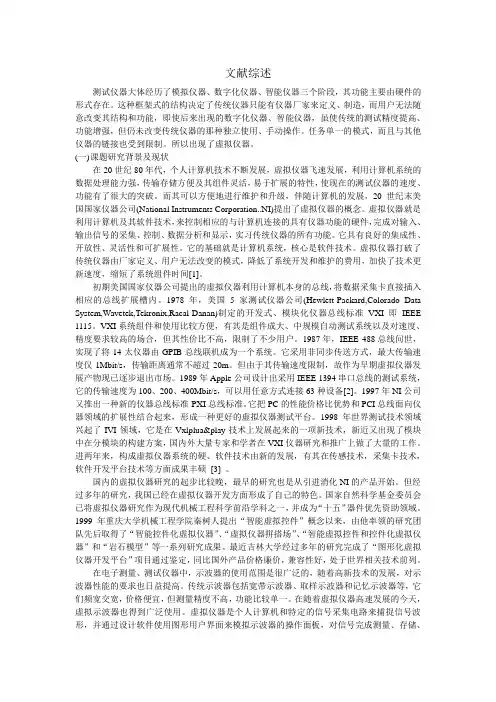
文献综述测试仪器大体经历了模拟仪器、数字化仪器、智能仪器三个阶段,其功能主要由硬件的形式存在。
这种框架式的结构决定了传统仪器只能有仪器厂家来定义、制造,而用户无法随意改变其结构和功能,即使后来出现的数字化仪器、智能仪器,虽使传统的测试精度提高、功能增强,但仍未改变传统仪器的那种独立使用、手动操作。
任务单一的模式,而且与其他仪器的链接也受到限制。
所以出现了虚拟仪器。
(一)课题研究背景及现状在20世纪80年代,个人计算机技术不断发展,虚拟仪器飞速发展,利用计算机系统的数据处理能力强,传输存储方便及其组件灵活,易于扩展的特性,使现在的测试仪器的速度、功能有了很大的突破。
而其可以方便地进行维护和升级,伴随计算机的发展,20世纪末美国国家仪器公司(National Instruments Corporation..NI)提出了虚拟仪器的概念。
虚拟仪器就是利用计算机及其软件技术,来控制相应的与计算机连接的具有仪器功能的硬件,完成对输入、输出信号的采集、控制、数据分析和显示,实习传统仪器的所有功能。
它具有良好的集成性、开放性、灵活性和可扩展性。
它的基础就是计算机系统,核心是软件技术。
虚拟仪器打破了传统仪器由厂家定义、用户无法改变的模式,降低了系统开发和维护的费用,加快了技术更新速度,缩短了系统组件时间[1]。
初期美国国家仪器公司提出的虚拟仪器利用计算机本身的总线,将数据采集卡直接插入相应的总线扩展槽内。
1978年,美国5家测试仪器公司(Hewlett-Packard,Colorado Data System,Wavetek,Tekronix,Racal-Danan)制定的开发式、模块化仪器总线标准VXI即IEEE 1115。
VXI系统组件和使用比较方便,有其是组件成大、中规模自动测试系统以及对速度、精度要求较高的场合,但其性价比不高,限制了不少用户。
1987年,IEEE 488总线问世,实现了将14太仪器由GPIB总线联机成为一个系统。
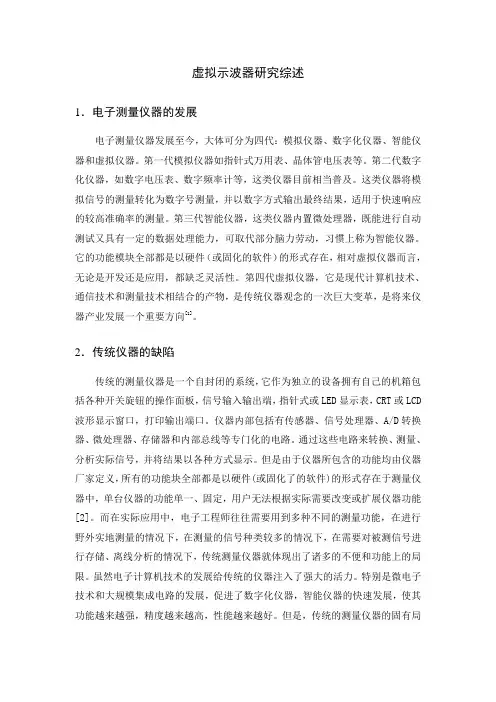
虚拟示波器研究综述1.电子测量仪器的发展电子测量仪器发展至今,大体可分为四代:模拟仪器、数字化仪器、智能仪器和虚拟仪器。
第一代模拟仪器如指针式万用表、晶体管电压表等。
第二代数字化仪器,如数字电压表、数字频率计等,这类仪器目前相当普及。
这类仪器将模拟信号的测量转化为数字号测量,并以数字方式输出最终结果,适用于快速响应的较高准确率的测量。
第三代智能仪器,这类仪器内置微处理器,既能进行自动测试又具有一定的数据处理能力,可取代部分脑力劳动,习惯上称为智能仪器。
它的功能模块全部都是以硬件(或固化的软件)的形式存在,相对虚拟仪器而言,无论是开发还是应用,都缺乏灵活性。
第四代虚拟仪器,它是现代计算机技术、通信技术和测量技术相结合的产物,是传统仪器观念的一次巨大变革,是将来仪器产业发展一个重要方向[1]。
2.传统仪器的缺陷传统的测量仪器是一个自封闭的系统,它作为独立的设备拥有自己的机箱包括各种开关旋钮的操作面板,信号输入输出端,指针式或LED显示表,CRT或LCD 波形显示窗口,打印输出端口。
仪器内部包括有传感器、信号处理器、A/D转换器、微处理器、存储器和内部总线等专门化的电路。
通过这些电路来转换、测量、分析实际信号,并将结果以各种方式显示。
但是由于仪器所包含的功能均由仪器厂家定义,所有的功能块全部都是以硬件(或固化了的软件)的形式存在于测量仪器中,单台仪器的功能单一、固定,用户无法根据实际需要改变或扩展仪器功能[2]。
而在实际应用中,电子工程师往往需要用到多种不同的测量功能,在进行野外实地测量的情况下,在测量的信号种类较多的情况下,在需要对被测信号进行存储、离线分析的情况下,传统测量仪器就体现出了诸多的不便和功能上的局限。
虽然电子计算机技术的发展给传统的仪器注入了强大的活力。
特别是微电子技术和大规模集成电路的发展,促进了数字化仪器,智能仪器的快速发展,使其功能越来越强,精度越来越高,性能越来越好。
但是,传统的测量仪器的固有局限性并没有根本改变[3]。
示波器论文班级:姓名:指导老师:日期:2014 / 4 / 22前言:示波器是一种用途十分广泛的电子测量仪器。
它能把肉眼看不见的电信号变换成看得见的图象,便于人们研究各种电现象的变化过程。
示波器利用狭窄的、由高速电子组成的电子束,打在涂有荧光物质的屏面上,就可产生细小的光点。
在被测信号的作用下,电子束就好像一支笔的笔尖,可以在屏面上描绘出被测信号的瞬时值的变化曲线。
利用示波器能观察各种不同信号幅度随时间变化的波形曲线,还可以用它测试各种不同的电量,如电压、电流、频率、相位差、调幅度等等。
摘要:用来测量交流电或脉冲电流波的形状的仪器,由电子管放大器、扫描振荡器、阴极射线管等组成。
除观测电流的波形外,还可以测定频率、电压强度等。
凡可以变为电效应的周期性物理过程都可以用示波器进行观测关键词:原理,波形,扫描一.示波器的组成及原理:1.示波器的基本结构示波管是示波器的核心部件,它主要包括电子枪、偏转板和荧光屏等几个部分,如图5所示。
示波管的电子枪包括灯丝、阴极、控制栅、第一阳极和第二阳极。
阴极被灯丝加热时发射大量电子,电子穿过控制栅后被第一阳极和第二阳极加速和聚焦,所以电子枪的作用是产生一束极细的高速电子射线。
由于两对平行的偏转板上加有随时间变化的电压,高速电子射线经过偏转板时就会在电场力的作用下发生偏转,偏转距离与偏转板上所加的电压成正比,最后电压射线高速撞在涂有荧光剂的屏幕上,产生可见的光点。
y轴放大器把被测信号电压放大到足够的幅度,然后加在示波管的垂直偏转板上。
Y轴放大器还带有衰减器,用来调节垂直幅度,确保显示图形的垂直幅度适当或进行定量测量。
这部分也称为y通道。
扫描信号发生器产生一个与时间成线性关系的周期性锯齿波电压(又称为扫描电压),经过X轴放大器放大以后,再加在示波管水平偏转板上,X 轴放大器也带有衰减器,其作用于Y轴所带衰减器相同。
这部分也称为X通道或扫描时基部分。
图-1 示波器的基本结构图(1)示波管:示波管是示波器的核心部件,它主要包括电子枪、偏转系统和荧光屏三部分,这三部分全部被密封在高真空的玻璃外壳内(如图-2所示)。
示波器原理及应用论文示波器是一种电子测试仪器,用于测量和显示电信号的波形。
它是电子技术领域中常用的设备,被广泛应用于电子工程、通信工程、医疗设备、自动化系统等领域。
本文将从示波器的原理和应用两个方面进行论述。
一、示波器的原理1. 示波器的基本原理示波器的基本原理是利用电子束在示波管内移动的方式,将输入的电信号转换为可视的波形。
当电信号作用于示波器的垂直输入端口时,信号被放大并转换成电压,然后通过水平扫描电路控制电子束在水平方向上的移动,同时通过垂直偏转电路控制电子束在垂直方向上的移动,最终在示波管屏幕上显示出信号的波形。
示波器的显示面板上有网格线,可以很直观地观察信号的周期、幅值、相位等特征。
2. 示波器的工作原理示波器的工作原理是通过控制电子束的位置和速度,将输入信号转换成二维图像。
示波器的垂直输入端口接收输入信号,并经过放大电路和垂直偏转电路后控制电子束的上下运动,水平扫描电路则控制电子束的水平运动。
当信号频率较高时,需要通过触发电路来确保每次扫描的起始点是一致的,从而确保波形的稳定显示。
3. 示波器的示波管原理示波器的核心部件是示波管,它是一种真空管,内部有电子枪、偏转板和荧光屏构成。
电子枪发射出的电子束被水平和垂直偏转板控制移动,最终击中荧光屏上,形成波形图像。
示波管的性能直接影响着示波器的显示效果,如分辨率、带宽等参数。
二、示波器的应用1. 电子工程在电子工程领域中,示波器被广泛应用于电路设计和故障诊断。
通过示波器可以观察到电路中各种信号的波形特征,如正弦波、方波、三角波等,从而判断电路工作状态是否正常。
同时,在故障诊断中,示波器可以观察到信号的变化,帮助工程师快速定位故障点,提高维修效率。
2. 通信工程在通信系统中,示波器用于分析和测试各种模拟和数字信号的波形。
通过示波器可以观察到信号的频率、相位、波形失真等特征,辅助工程师进行通信系统的设计和优化。
3. 医疗设备在医疗设备中,示波器被用于监测生物信号的波形,如心电图、脑电图等。
示波器示波器是一种用途十分广泛的电子测量仪器。
它能把肉眼看不见的电信号变换成看得见的图象,便于人们研究各种电现象的变化过程。
示波器利用狭窄的、由高速电子组成的电子束,打在涂有荧光物质的屏面上,就可产生细小的光点。
在被测信号的作用下,电子束就好像一支笔的笔尖,可以在屏面上描绘出被测信号的瞬时值的变化曲线。
利用示波器能观察各种不同信号幅度随时间变化的波形曲线,还可以用它测试各种不同的电量,如电压、电流、频率、相位差、调幅度等等。
目录组成显示电路垂直(Y轴)放大电路水平(X轴)放大电路扫描与同步电路电源供给电路示波器分类模拟示波器数字示波器示波器参数特征分类通道数分类带宽分类基本原理波形显示的基本原理双线示波的显示原理双踪示波的显示原理使用方法(二)使用前的检查、调整和校准(三)使用步骤注意事项常见现象没有光点或波形水平方向展不开垂直方向无展示波形不稳定垂直线条密集或呈现一矩形水平线条密集或呈一条倾斜水平线垂直方向的电压读数不准水平方向的读数不准交直流叠加信号的直流电压值分辨不清测不出两个信号间的相位差调幅波形失常波形调不到要求的起始时间和部位触发或同步扫描使用不当造成的异常现象测试应用电压的测量时间的测量相位的测量频率的测量注意事项示波器知名厂商组成显示电路垂直(Y轴)放大电路水平(X轴)放大电路扫描与同步电路电源供给电路示波器分类模拟示波器数字示波器示波器参数特征分类通道数分类带宽分类基本原理波形显示的基本原理双线示波的显示原理双踪示波的显示原理使用方法(二)使用前的检查、调整和校准(三)使用步骤注意事项常见现象没有光点或波形水平方向展不开垂直方向无展示波形不稳定垂直线条密集或呈现一矩形水平线条密集或呈一条倾斜水平线垂直方向的电压读数不准水平方向的读数不准交直流叠加信号的直流电压值分辨不清测不出两个信号间的相位差调幅波形失常波形调不到要求的起始时间和部位触发或同步扫描使用不当造成的异常现象测试应用电压的测量时间的测量相位的测量频率的测量注意事项示波器知名厂商展开编辑本段组成显示电路显示电路包括示波管及其控制电路两个部分。
文献综述手持示波器的现状手持数字示波表是近年出现的一种新型的检测仪表,主要功能覆盖数字存储示波器和数字万用表,可满足机动现场维护、后勤保障、工业生产以及教育系统等领域移动测试的需求。
与台式的数字示波器相比,手持数字示波表具有轻巧、便携的特性,可以满足现场苛刻环境下的精确测量。
目前国内市场上常见的国外品牌有Fluke、Tektronix、Metrix 、Svmmit、Velleman、Metex等,其中美国福禄克(Fluke作为手持示波表测量领域的行业龙头,形成了强大的品牌效力。
从国内的的市场调查来看,国内近几年对手持示波表的需求量每年可达上万台。
F120系列是福禄克(Fluke公司销售量较大的产品系列,分F123和F124两款,带宽分别为20MHz 和40MHz,采样率为25MSa/s。
因此,从行业需求上来看,20MHz带宽的产品是目前市场的主流。
面对这样的行业需求,国内示波器生产企业把产品性能设定在20MHz带宽、100MSa/s采样率。
采用双通道数据采集,一般是单色LCD显示。
一、几款手持示波器的参数● AEMC OX 7104-C(100MHz,四通道;● Fluke 199C(200MHz,两通道;● Agilent Technologies U1604A(40MHz,两通道;● Protek 860F(60MHz,两通道。
AEMC OX 7104-CAEMC的OX 7104-C是市售的唯一一种四通道手持式示波器。
12位分辨率、100MHz 带宽和触摸显示屏使其性能居于领先地位。
5995美元的高价格使其较适合于确实很需要便携性的场合。
如果不是特别需要便携性,可以找到大量具有相当价格和性能的台式示波器,不过多数都只有8位分辨率,而AEMC的分辨率为12位。
AEMC的手持式示波器包括一个谐波分析仪,适用于分析电源质量,可覆盖40Hz到450Hz的频率范围。
在低电压下,在最高5kHz的频率下可获得可靠的结果。
示波器发展现状
示波器是一种用于测量和显示电信号波形的重要仪器。
随着电子技术的发展,示波器在各个领域得到了广泛的应用,并不断进行着创新和改进。
首先,示波器的技术水平不断提高。
过去的示波器主要采用模拟技术,而现在大部分示波器采用数字技术。
数字示波器具有更高的精度、更大的动态范围和更高的带宽,能够显示更复杂的信号波形。
其次,示波器的功能不断增加。
现代示波器不仅能够显示波形,还能进行各种测量和分析。
例如,示波器可以进行频谱分析、功率分析和时序分析等,方便工程师对信号进行深入研究。
另外,示波器的体积逐渐减小。
随着微电子技术的发展,示波器的尺寸越来越小,便于携带和移动。
这种便携式示波器广泛用于现场测量和维修工作。
此外,示波器的操作界面也得到了改进。
过去的示波器使用旋钮和按钮进行操作,不够直观和方便。
现在的示波器大多配备了触摸屏,操作更加简单和直观。
最后,示波器还与其他设备进行了更好的集成。
现代示波器可以通过网络与电脑、手机等设备进行连接,实现数据传输和远程控制。
这种集成功能使得示波器与其他设备更加便捷地进行协作。
总的来说,示波器在技术水平、功能、体积和操作界面等方面都得到了不断的改进和发展。
这些改进使得示波器更加适应现代化的测量需求,并在各个领域发挥着重要的作用。
示波器发展现状示波器是一种用于观察和测量电信号波形的仪器,广泛应用于电子、通信、医疗、生物等领域。
随着科技的发展,示波器也经历了许多变革与创新。
下面将从技术、功能和应用等方面介绍示波器的发展现状。
技术方面,示波器的发展以数字化为主导。
传统模拟示波器在测量电信号时需要使用示波管和电子枪来显示波形。
而现代示波器采用了数字化技术,将电信号转换为数字信号进行处理和显示。
这种数字示波器具有更高的精度、更大的带宽和更多的测量功能。
另外,随着高速通信和高频率电子器件的出现,示波器的带宽也不断提高,目前已经达到了几百GHz的水平。
功能方面,示波器具有更多的测量功能和分析能力。
现代数字示波器可以进行多通道测量,实时采样和存储、自动测量、频谱分析等功能。
这些功能使得示波器能够更方便地进行信号测量和分析。
同时,示波器还可以与其他测试仪器和计算机进行连接,实现更高级的数据处理和自动化测试。
应用方面,示波器的应用范围越来越广泛。
在电子制造和维修领域,示波器是必备的仪器之一,用于测试和分析电路的各种信号。
在通信领域,示波器可以用于测试和分析高速数据传输和通信信号。
在医疗和生物领域,示波器可以用于检测生理信号和医疗设备的性能。
此外,在学术研究和工程设计中,示波器也被广泛应用。
总的来说,示波器在技术、功能和应用方面都有了长足的发展。
数字化技术的应用使示波器具有了更高的精度和更多的测量功能。
同时,示波器在各个领域的应用越来越广泛,为科学研究和工程设计提供了强有力的工具。
未来,随着科技的不断进步,示波器的发展还将继续,为各个行业提供更好的测试和分析解决方案。
目录目录目录 (1)1、项目概述 (2)2、数字示波器的基本原理及特点 (2)2.1、基本原理 (2)2.2、主要特点 (2)2.3、主要技术指标 (3)3、系统总体设计方案 (4)3.1、方案论证比较 (4)3.2、系统详细功能图 (7)3.2.1、程控放大 (7)3.2.2、高速A/D (7)3.2.3、FPGA (8)3.2.4、ARM处理器 (8)4、参考文献 (8)1、项目概述示波器作为电子工程师常用的一种电子测量仪器,它能测试出高速变化的信号的不同电量,如电压、电流、频率、相位、调幅度等等。
能够帮助工程师快速发现设计者存在的问题,用途十分广泛。
然而传统的示波器体积大、功耗高、价格昂贵、对工作电压要求高等等的特性,让传统的示波器只能使用在实验室中,对于需要现场测量的一些信号,就可能有心无力了。
相比较而言,手持示波器体积小,功耗低,工作电压要求低,使用方便灵活。
手持示波器正在以这些优秀的性质,在市场上占据越来越多的比重。
目前,国内具有自主知识产权的数字存储示波器产品还非常少,高昂的价格阻碍了数字存储示波器在生产和试验中广泛的应用。
在研究剖析数字存储示波器产品工作原理的基础上,本文利用ARM+FPGA设计示波器,并详细论述了其设计和实现过程2、数字示波器的基本原理及特点2.1、基本原理数字示波器就是利用A/D转换器将模拟信号转换为数字信号,然后存储在半导体存储器FIFO中,需要时从FIFO读取相应的数据,通过ARM处理器将读取到的数据显示在TFT彩屏之上。
数字示波器的主要性能取决于A/D转换器、FIFO读写速度、微处理器等,因此,相比较模拟示波器而言,数字示波器精度更高,处理速度可以达到更快。
2.2、主要特点与模拟示波器相比较,数字示波器有很多特点,主要如下:1、具备波形存储的功能,存储的时间可以无限延长,对于观察单次脉冲信号极为重要。
2、波形的存储取样与显示是两个独立的环节,对于较高频率的信号可以采用高速的采样及存储,对于频率低的信号可以较低速率的取样与存储。
显示部分可以选择一个相对固定的读取速度,以获得较清晰稳定的波形。
3、测量准确率高,采用晶体振荡器作为时钟输入,数字示波器有很高的测时准确性,同时高分辨率的A/D 转换器,也使测试的结果精度大大提高。
4、示波器可以有很强的数据处理能力,内部使用微处理器,能实现多种参数的测量,如上升时间,下降时间,峰峰值,脉宽等参数,还能对波形进行频谱分析,实现平均值,取上下限等复杂的运算处理。
5、可以与外部进行通讯,有了数据外部接口,数字示波器可以方便的将存储的数据发送到计算机或其他的外部设备。
通过计算机实现更复杂的数据分析及运算处理。
2.3、主要技术指标(1)频带宽度当示波器输入不同频率的等幅正弦信号时,屏幕上显示的信号幅度下降3dB 所对应的输入信号上、下限频率之差,称为示波器的频带宽度,单位为MHz 或GHz 。
(2)采样速率:采样速率是指单位时间内在不连续的时间点上获取模拟输入量并进行量化的次数,也称数字化速率,单位用Sa/s ( Sampling/s )表示。
用每秒钟完成的AD 转换的最高次数来衡量。
常以频率来表示,取样速率越高,反应仪器捕捉高频或快速信号的能力愈强。
取样速率主要由AD 转换速率来决定。
数字存储示波器的测量时刻的实时取样速率可根据被测信号所设定的扫描时间因数(即扫描一格所用的时间)来推算。
其推算公式为div t N f /(1) 式中,N 为每格的取样点数,t 为扫描时间因数。
在进行信号数字化的时候为保持足够的信号细节,就要求采样时钟的频率至少应为信号本身所包含的最高频率的两倍。
这个要求通常成为香农采样定理或者乃奎斯特定律。
然而,为了避免混叠现象和较好的再现所测信号的波形,示波器的采样率一般需要达到被测信号频率的10倍甚至20倍以上。
如此的话,在不少情况下,就会存在显示点数不够的问题,例如用采样率为500MS/s的示波器观测100MHz的正弦信号,则每个周期上只显示5个采样点,观测效果较差。
(3)分辨率分辨率指示示波器能分辨的最小电压增量,即量化的最小单元。
它包括垂直电压灵敏度(电压分辨率)和水平时间灵敏度(时间分辨率)。
垂直电压灵敏度与AD转换的分辨率相对应,常以屏幕每格的分级数(级/div)或百分数来表示。
水平时间灵敏度由取样速率和存储器的容量决定,常以屏幕每格含多少个取样点或用百分数来表示。
取样速率决定了两个点之间的时间间隔,存储容量决定了一屏内包含的点数。
一般示波管屏幕上的坐标刻度为8*10div(即屏幕垂直显示格为8格,水平显示格为10格),如果采用8位的AD转换器(256级),则垂直分辨率表示为32级/div,或用百分数来表示为1/256=0.39%:如果采用容量为1k 的RAM,则水平分辨率为1024/10=100点/div。
(4)存储容量存储容量又称记录长度,它由采集存储器(主存储器)最大存储容量来表示,常以字为单位。
数字存储器常采用256,512,1K等容量的高速半导体存储器。
3、系统总体设计方案本章主要对数字存储示波器的外部特性进行分析,描述示波器的主要功能及示波器的输入与输出阐述示波器功能的基本框图与基本原理。
3.1、方案论证比较方案一:采用80C51单片机为控制核心,其系统框图如图3.1.1所示。
对输入信号进行放大或衰减后,用外接触发电路产生触发信号,通过A/D转换将模拟信号转换成数字信号,再通过单片机将数据锁存至外部RAM,然后由单片机控制将数据送至D/A输出。
图3.1.1方案一系统框图这种方案结构较为简洁,但很明显,A/D的最高采样速度达1MHz,由普通单片机直接处理这样速率的数据难以胜任,采用高档单片机甚至采用DSP芯片,成本偏高不说,还将大大增加开发的难度。
而且目前常用的外接RAM芯片时钟周期一般为40MHz~50MHz,难以达到高速数据存储的要求。
方案二:用FPGA可编程逻辑器件作为控制及数据处理的核心,利用FPGA的层次化存储器系统结构,使用FPGA内部集成的基本逻辑功能块配置成双端口同步RAM对采集信号进行存储,完成设计指标。
其系统框图如图3.1.2所示。
图3.1.2方案二系统框图由于FPGA可在线编程,因此大大加快了开发速度。
电路中的大部分逻辑控制功能都由单片FPGA完成,多个功能模块如采样频率控制模块、数据存储模块都集中在单个芯片上,大大简化了外围硬件电路设计,增加了系统的稳定性和可靠性。
FPGA的高速性能比其他控制芯片更适合于高速数据采集和处理,而且使用FPGA内部存储模块完成输入信号的量化存储,在存储速度上有着外接RAM无法比拟的优势。
方案三:以Cortex-M3内核的ARM为主控制器以FPGA相配合的方案如下面图3.1.3所示:图3.1.3方案三系统框图微处理器采用32位处理器,内部采用ARM公司Cortex-M3内核,工作主频最高可达72MHz,再在其上面移植开源的实时操作系统µC/OS-II系统,确保系统的实时性和稳定性。
由于高速A/D转换器的速度太快,ARM处理数据的速度跟不上,所以在中间加入FIFO高速缓存器。
利用ARM来控制TFT液晶屏刷新波形,可实现更高频率的信号的波形刷新和显示。
方案比较:方案一虽然简单,但是51单片机处理能力有限,无法实现数字示波器的基本指标;方案二采用FPGA虽然能深入开发数字示波器,然而,其成本偏高,即使加入SOPC软核,其软件压力也很大。
方案三是能够实现嵌入式数字示波器基本指标的良好方案,器件成本不高,实时操作系统µC/OS-II 简化编程,提供系统实时性和稳定性,FPGA为ARM提供各种支持。
因此,本设计最终选择方案三开展设计。
3.2、系统详细功能图3.2.1、程控放大信号的处理主要是对被测输入信号在幅度与偏移方面进行线性处理,使信号在垂直方向上处于A/D转换器的输入范围内。
待测模拟信号输入到数字示波器时首先要经过相关的处理才能够送给ADC,因为ADC对输入电压的幅度有一定的要求,一般为0-5V,或者0-2V等。
对于输入的模拟信号,要根据不同的垂直灵敏度做出调整,具体说就是把小电压信号放大,将大电压信号衰减使之符合ADC的输入电压范围。
因此,需要对电压大小不同的信号进行增益调整。
通常可以使用增益可调的放大电路。
需要注意的是放大电路的增益系数和频带的关系。
同时,为防止ADC因输入大的电压信号而烧毁,可以加入限幅电路。
处理过的模拟信号需要经过ADC进行量化编码。
通常在进行A/D转换之前要加上比较电器,作为模拟电路和数字电路之间的接口电路。
3.2.2、高速A/DA/D转换器ADS830是德州仪器公司的一个8位分辨率高速模数转换器,其采样频率范围是10kSa/s~ 60MSa/s。
它的参考电压源可选择为内部参考和外部参考,这里为了简化设计,选用它的内部参考电压源。
虽然ARM主频最高高达72MHz,但是在程序里对A/D采集回来的数据的处理速度实际上是比不上ADS830的60MHz采样频率的,所以为了缓冲高速数据,中间加入高速缓存器FIFO。
FIFO(先进先出)存储器,工作方式是不依靠地址线,随着写入或读取信号来对数据指针进行递加或递减,来实现对数据的寻址。
FIFO是例化FPGA内部资源得到的,存储深度可随时更改,暂时定为4K,还有两个存储标志位,数据满和数据空标志。
这里用到了它的“数据满标志”,当ARM读取数据满标志,如果为高,证明FIFO存储器已经读取了4096个ADS830的数据,然后暂停对A/D转换器数据的读取。
ARM处理当前存储区的数据;等待出来完毕,再次让FIFO读取ADS830的数据,如此循环即可得到当前示波器输入信号的完整波形数据。
3.2.3、FPGA主要用到了FPGA例化了一个FIFO,为高速A/D与ARM的接口提供一个高速数据缓存,可以灵活的控制系统功能,通过LED显示FPGA内部FIFO的读写控制信号,以及FIFO的状态,通过FPGA内部的锁相环模块,提供给A/D稳定的采样频率,对信号的频率进行测量,将信号频率信息传送到ARM,由ARM灵活的控制FIFO的读写时序。
FPGA内部还有一个供测试的串口模块,可以与各种满足串口通讯协议的设备通讯。
3.2.4、ARM处理器ARM处理器模块使整个系统的核心,它需要接收FPGA内部FIFO传输过来的数据,还原波形,由按键选择触发方式,调节增益大小,控制FIFO时序,显示人机交互的画面,驱动彩屏,显示各种波形的数据,通过USB接口与上位机通讯。
4、参考文献[1]周永宏.基于ARM和CPLD的便携式数字存储示波器硬件平台设计. 2005.04[2]夏宇闻. verilog数字系统设计教程. 北京航天航空大学出版社.2013.07[3]吴厚航. 深入浅出玩转FPGA. 北京航天航空大学出版社.2008.06[4]EDA先锋工作室. Altera_FPGA/CPLD设计_基础篇.人民邮电出版社.2005.07[5]朱明强.基于单片机及CPLD的数字存储示波器的研究与设计. 2008.06[6]张雅珍.基于FPGA和ADS830数字示波器设计. 电子测量技术.2009,32(10)[7]何敬银,李会平.基于FPGA的便携式数字示波器的设计与实现. 青岛大学学报.2013.09[8]黄成林.基于FPGA数字存储示波器的设计. 2008.01。